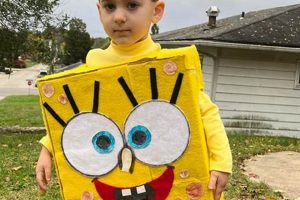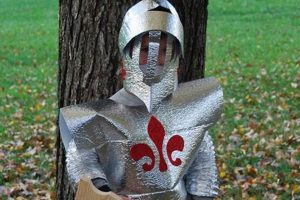A homemade fox outfit offers a personalized alternative to store-bought options for costume events. Construction typically involves utilizing readily available materials such as felt, fabric scraps, and repurposed clothing items to create characteristic fox features like pointed ears, a bushy tail, and distinctive facial markings. Examples range from simple ear and tail attachments suitable for younger children to more elaborate full-body suits designed for adults.
Creating such an attire fosters creativity and resourcefulness, providing a budget-friendly solution for themed parties, theatrical productions, or Halloween. The act of crafting the costume allows for customization to individual preferences regarding color palettes, styles, and the degree of realism depicted. Historically, homemade costumes have served as a significant aspect of celebratory traditions, representing a tangible expression of individual artistry and community involvement.
Subsequent sections will delve into detailed instructions for crafting various components of a fox-themed ensemble, encompassing methods for designing and assembling ears, tails, and makeup applications that complete the overall aesthetic. Furthermore, the article will explore diverse material choices and techniques that accommodate various skill levels and desired levels of complexity.
Crafting a Superior Homemade Fox Attire
The following recommendations aim to enhance the construction and longevity of a fox-themed homemade outfit, ensuring a visually appealing and durable result.
Tip 1: Prioritize Material Selection. Opt for high-quality felt or fleece for key components such as ears and tails. These materials offer durability and prevent premature wear, contributing to the costume’s overall lifespan.
Tip 2: Reinforce Seams Strategically. Focus on reinforcing seams at stress points, particularly where the tail attaches to the body and around the ear attachments. This preventative measure reduces the risk of detachment during wear.
Tip 3: Implement Wire Armature for Tail Structure. Integrate a flexible wire armature within the tail construction to allow for poseability and maintain its characteristic shape. Exercise caution to ensure the wire ends are securely covered to prevent injury.
Tip 4: Utilize Templates for Consistent Shapes. Employ pre-made or self-designed templates for creating multiple identical shapes, such as ear pieces or facial markings. This technique ensures uniformity and a polished appearance.
Tip 5: Incorporate Reflective Elements for Safety. Integrate reflective tape or fabric strips into the costume, especially if it will be worn in low-light conditions. This addition enhances visibility and contributes to the wearer’s safety.
Tip 6: Secure Fastenings Meticulously. Select robust fasteners, such as heavy-duty Velcro or sturdy snaps, to ensure secure attachment of costume components. Weak or unreliable fastenings can lead to malfunctions and detract from the overall aesthetic.
Tip 7: Consider Breathability and Comfort. When designing full-body suits, prioritize breathable fabrics and incorporate ventilation features to prevent overheating and ensure the wearer’s comfort. This is especially critical for extended wear periods.
Adhering to these guidelines will result in a more professional-looking and enduring homemade fox attire. The emphasis on material quality, structural reinforcement, and attention to detail are fundamental to a successful outcome.
The subsequent sections will offer specific techniques for detailed fabrication of various costume elements, building upon the foundational principles presented herein.
1. Material Selection
Material selection is a foundational element in the creation of a homemade fox attire. The choice of materials directly influences the costume’s appearance, durability, comfort, and overall cost. Inadequate material choices can compromise the final product, while thoughtful selection enhances its quality and longevity.
- Fabric Type and Texture
The primary fabric dictates the overall look and feel of the costume. Fleece offers a soft, comfortable option ideal for younger children, while felt provides a more structured appearance and is suitable for crafting smaller components. Consideration must be given to the fabric’s texture; a rough texture may be uncomfortable against the skin, while a smooth texture may lack visual interest. Velvet or faux fur can add a touch of realism, but increase the cost and complexity of construction.
- Color Palette and Variation
Foxes exhibit a range of coloration, from classic reddish-orange to silver and even melanistic (black) variations. Material selection must account for achieving the desired color palette. Dyeing fabrics can allow for custom hues, but requires expertise and may compromise material integrity. Pre-dyed fabrics offer convenience and consistency. Variation in color can be achieved through layering different materials or employing techniques like airbrushing to create realistic shading.
- Durability and Wear Resistance
The intended use of the costume dictates the required level of durability. A costume intended for light use, such as a single Halloween event, may require less robust materials than one designed for repeated wear in theatrical productions. Reinforced stitching and durable fabric choices, such as canvas or heavy-duty felt, enhance wear resistance and prevent premature damage. Materials must withstand washing and potential abrasion without significant degradation.
- Cost and Accessibility
Material costs can vary significantly depending on the type, quality, and source. Balancing the desired aesthetic and durability with budget constraints is essential. Readily accessible materials, such as repurposed clothing or inexpensive felt, provide a cost-effective option. However, investing in higher-quality materials may ultimately result in a more durable and visually appealing costume, extending its lifespan and justifying the initial expenditure. The availability of specific materials in local craft stores or online retailers also influences material selection.
The interplay between fabric type, color, durability, and cost underscores the importance of careful material selection when creating a fox-themed attire. By strategically considering these factors, individuals can craft costumes that are both visually appealing and functionally sound, maximizing the creative potential of the project while remaining within budgetary and skill-level constraints.
2. Pattern Creation
Pattern creation constitutes a critical phase in the construction of a homemade fox attire. Accurate and well-designed patterns serve as the foundation upon which the costume’s form and functionality are built. The absence of a reliable pattern can lead to dimensional inacc
uracies, structural instability, and an aesthetically displeasing final product.
- Dimensional Accuracy and Fit
Patterns dictate the size and proportions of individual costume pieces, influencing the overall fit. Precise measurements and careful drafting are essential for achieving a comfortable and visually appealing result. Ill-fitting components, such as oversized ears or a disproportionately long tail, can detract from the costume’s realism and limit the wearer’s mobility. Standardized sizing charts or custom measurements are crucial for ensuring dimensional accuracy.
- Component Definition and Complexity
Patterns define the shape and construction of individual components, such as the headpiece, body suit, and tail. Complex patterns involving multiple pieces and intricate seam lines allow for a more realistic and detailed design. Conversely, simpler patterns with fewer components are suitable for beginner-level projects or when prioritizing speed and ease of construction. The level of detail incorporated into the pattern directly impacts the final costume’s visual impact.
- Material Efficiency and Waste Reduction
A well-designed pattern optimizes material usage by minimizing waste. Strategic placement of pattern pieces on the fabric minimizes unusable scraps and reduces the overall cost of materials. Interlocking patterns or modular designs further enhance material efficiency. Careful planning during the pattern creation phase can significantly impact the environmental footprint of the project and contribute to resource conservation.
- Adaptability and Customization
Patterns serve as a template for customization and adaptation. Modifications to the original pattern can allow for personalized design elements, such as unique color combinations, fabric embellishments, or alterations to the character’s features. A flexible pattern design facilitates experimentation and allows for individual expression within the framework of the fox-themed concept. The ability to adapt and customize patterns is a key advantage of homemade costume creation.
The nuances of pattern creation, from ensuring accurate dimensions to optimizing material usage and enabling customization, are integral to the success of any homemade fox attire. The pattern effectively bridges the gap between conceptual design and tangible construction, translating creative vision into a wearable and aesthetically pleasing costume.
3. Construction Techniques
The viability of a homemade fox attire hinges significantly on the employed construction techniques. These methods directly influence the costume’s structural integrity, aesthetic appeal, and wearer comfort. Inadequate construction processes inevitably lead to a compromised final product, characterized by premature wear, visual defects, and restricted movement. For example, utilizing a basic running stitch in place of a reinforced seam for tail attachment introduces a high risk of detachment during use. Conversely, employing techniques like pattern grading ensures accurate scaling of costume components to different body sizes, enhancing both fit and visual proportionality. Thus, the selection and execution of suitable construction methodologies are paramount to a successful outcome.
Practical applications of diverse construction techniques are evident in various costume elements. The creation of realistic fox ears necessitates precision cutting and sewing techniques to achieve the desired shape and curvature. Padding and internal support structures may be incorporated to maintain rigidity and prevent drooping. Tail construction often benefits from techniques like armature insertion, which allows for poseability and prevents the tail from collapsing under its own weight. Furthermore, the application of appropriate finishing techniques, such as edge binding and seam finishing, enhances durability and prevents fraying, contributing to the costume’s overall longevity and visual appeal. Careful consideration of fabric properties and intended use dictates the most suitable construction approach for each component.
In summary, construction techniques are not merely procedural steps, but fundamental determinants of a homemade fox attire’s success. Proficiency in these methods allows for translating conceptual designs into tangible, wearable creations characterized by structural soundness, aesthetic refinement, and wearer comfort. While challenges such as material limitations and skill-level constraints exist, a comprehensive understanding of these techniques empowers individuals to create personalized and durable costumes that effectively capture the essence of the fox character.
4. Finishing Touches
The creation of a successful fox attire hinges significantly on the execution of finishing touches. These details, though seemingly minor, often determine the overall impact and perceived quality of the costume. The absence of carefully considered finishing touches can diminish the effect of even well-constructed core components. For instance, a costume with meticulously crafted ears and tail may appear incomplete if the facial markings are crudely applied or the edges of fabric are left unfinished, leading to fraying. Finishing touches transform a collection of parts into a cohesive and believable representation of a fox.
Examples of vital finishing touches include detailed face painting techniques designed to mimic the characteristic fox mask, proper hemming and edge finishing to prevent fraying and enhance durability, and the strategic addition of accessories such as paw-like gloves or spats to complete the ensemble. Furthermore, the meticulous application of shading and highlighting using fabric paint or airbrushing can add depth and realism to the costume’s fur texture. These details, while requiring additional time and effort, contribute significantly to the costume’s visual fidelity and overall impression.
In conclusion, finishing touches are integral to the success of any homemade fox attire. These elements elevate the costume from a mere collection of parts to a visually compelling and believable representation. Though challenges may arise in mastering specific techniques, the enhanced realism and extended lifespan achieved through careful attention to detail justify the added effort. The effective implementation of finishing touches underscores the commitment to quality and transforms a simple homemade project into a statement of craftsmanship.
5. Cost Effectiveness
The economic advantage inherent in crafting a fox-themed attire stems from the potential to significantly reduce expenditure compared to purchasing pre-made costumes. This cost-effectiveness is a primary motivator for individuals opting for the “diy fox costume” approach, allowing for creative expression within budgetary constraints.
- Material Sourcing Strategies
The selection of materials profoundly impacts the overall cost. Repurposing existing textiles, such as old clothing or fabric scraps, provides a cost-free or low-cost base for the costume. Thrift stores and discount fabric outlets offer economical alternatives to
purchasing new materials at retail prices. Skillful sourcing and material selection are key to maximizing cost efficiency in a “diy fox costume” project. - Tool and Equipment Investment
While some specialized tools may be required, many individuals possess essential items like sewing machines, scissors, and glue guns. Borrowing or renting specialized equipment further reduces the financial burden. Investing in durable, multi-purpose tools, if necessary, provides long-term cost benefits by enabling future crafting projects and eliminating the need for repeated purchases.
- Labor Cost Considerations
The primary labor involved in creating a “diy fox costume” is the individual’s time and effort. This represents an opportunity cost, as time spent on costume construction could be allocated to other activities. However, the satisfaction derived from creating a personalized item and the potential for acquiring new skills often outweigh this cost. The value of the finished product, reflecting the invested labor, frequently surpasses the price of a comparable store-bought costume.
- Customization and Reusability Value
A key advantage of a homemade attire is the ability to customize the design to specific preferences and requirements. This level of personalization is often unavailable in mass-produced costumes. Furthermore, with proper care and storage, a “diy fox costume” can be reused for multiple events, extending its value and reducing the need for future costume purchases. Durability considerations during construction further enhance the reusability and long-term cost effectiveness of the project.
These multifaceted cost considerations collectively emphasize the financial advantages associated with crafting a “diy fox costume”. Strategic material sourcing, efficient tool utilization, mindful labor allocation, and the inherent value of customization and reusability all contribute to the overall cost-effectiveness of this approach, making it an economically viable and creatively rewarding option for individuals seeking a personalized costume solution.
6. Wearer Comfort
The degree of comfort experienced by the wearer significantly influences the success of a homemade fox attire. A costume, regardless of its visual appeal, will fail to meet its intended purpose if it restricts movement, causes irritation, or induces overheating. Thus, wearer comfort is not merely a desirable attribute but a critical factor in the overall design and construction of a “diy fox costume.” Practical examples illustrate this point: a childs enthusiasm for a fox costume diminishes rapidly if the headpiece is too tight, or if the fabric causes excessive sweating. Adult participants in theatrical productions similarly require costumes that allow for extended wear and physical activity without causing undue discomfort. The long-term viability of a “diy fox costume” as a cherished item or a functional garment depends directly on its comfort level.
Several construction choices directly impact wearer comfort. Fabric selection plays a pivotal role; natural fibers like cotton or linen offer breathability, reducing the risk of overheating, while fleece provides warmth in colder environments. Seam placement is also crucial; seams positioned in areas of high friction can cause chafing. The use of flatlock seams or soft seam tape can mitigate this issue. Headpieces require careful consideration of weight and ventilation; overly heavy headpieces can cause neck strain, while inadequate ventilation leads to discomfort from trapped heat. Similarly, tail attachments should be secure yet flexible to prevent constriction or hinderance of movement. Thoughtful design choices related to fit, fabric, and construction techniques are therefore essential to ensure a comfortable and enjoyable wearing experience.
In summary, wearer comfort is an indispensable component of any successful “diy fox costume”. This consideration necessitates thoughtful design choices in material selection, seam placement, and ventilation strategies. By prioritizing wearer comfort alongside visual aesthetics, individuals can create fox-themed attires that are not only visually appealing but also enjoyable to wear, thereby maximizing the costume’s value and utility. Failure to address comfort considerations can lead to a neglected costume, regardless of its artistic merit.
Frequently Asked Questions Regarding Homemade Fox Attire Construction
The subsequent questions and answers address common inquiries and potential challenges encountered during the creation of a fox-themed homemade outfit. Adherence to these recommendations may improve the outcome and longevity of the project.
Question 1: What constitutes the most suitable material for constructing a durable fox tail?
Durable fox tails typically utilize high-quality felt, fleece, or faux fur. Reinforcement with internal wire armature is recommended for maintaining shape and preventing sagging. Secure attachment to the costume base is paramount.
Question 2: How may potential skin irritation from costume materials be minimized?
Skin irritation is minimized by selecting hypoallergenic fabrics and ensuring that all seams are smooth and well-finished. A barrier layer of soft, breathable fabric, such as cotton, between the costume and the skin can further reduce the risk.
Question 3: What methods exist for achieving a realistic fur texture in a homemade fox costume?
Realistic fur texture can be achieved through strategic layering of different fabric types, the application of fabric paint or airbrushing to create shading and highlights, and the use of specialized techniques such as faux fur trimming.
Question 4: What safety precautions should be observed when incorporating accessories, such as masks or claws, into the costume?
Accessories should be constructed from lightweight, non-toxic materials and securely attached to the costume. Masks must allow for adequate visibility and ventilation. Claws should be blunt and flexible to prevent injury.
Question 5: How can the overall cost of creating a fox-themed homemade outfit be minimized without compromising quality?
Cost reduction strategies include repurposing existing materials, sourcing fabrics from discount outlets, borrowing or renting specialized equipment, and opting for simpler construction techniques that require less time and resources.
Question 6: What techniques are recommended for cleaning and maintaining a homemade fox costume to ensure its longevity?
Cleaning and maintenance protocols depend on the fabric type. Hand washing is generally recommended for delicate materials. Storing the costume in a dry, well-ventilated area, away from direct sunlight, prevents fading and deterioration. Regular inspection for damage and prompt repairs are essential.
The successful creation and maintenance of a fox-themed homemade outfit requires careful attention to material selection, construction techniques, and safety considerations. Adherence to these guidelines will enhance the quality and longevity of the finished product.
The subsequent section will delve into specific design variations and aesthetic considerations for customizing a fox-themed attire.
Conclusion
This exploration has detailed the multifaceted aspects of the “diy fox costume,” from material selection and pattern creation to construction techniques, finishing touches, cost-effectiveness, and wearer comfort. T
he analysis underscores the importance of informed decision-making at each stage of the process to achieve a successful and enduring outcome. Consideration of each element allows for a personalized and practical creation.
The creation of a fox-themed homemade attire represents a tangible expression of individual artistry and resourcefulness. Continued exploration and refinement of these techniques will foster innovation and enhance the accessibility of personalized costume design for a broader audience. Embrace this creative endeavor to craft a unique attire that reflects individual style and artistic vision.







